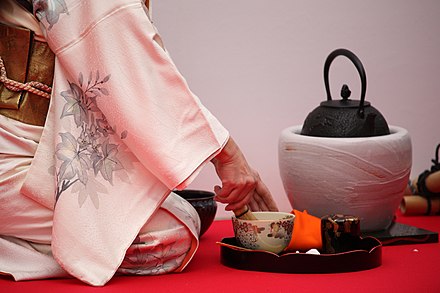History

In China during the Tang dynasty (618–907), tea leaves were steamed and formed into tea bricks for storage and trade. The tea was prepared by roasting and pulverizing the tea, and decocting the resulting tea powder in hot water, then adding salt. During the Song dynasty (960–1279), the method of making powdered tea from steam-prepared dried tea leaves, and preparing the beverage by whipping the tea powder and hot water together in a bowl became popular.
Preparation and consumption of powdered tea was formed into a ritual by Chan or Zen Buddhists. The earliest extant Chan monastic code, titled Chanyuan Qinggui (Rules of Purity for the Chan Monastery, 1103), describes in detail the etiquette for tea ceremonies.
Zen Buddhism and the Japanese methods of preparing powdered tea were brought to Japan in 1191 by the monk Eisai. In Japan, it became an important item at Zen monasteries and from the 14th through to the 16th centuries was highly appreciated by members of the upper echelons of society. Although powdered tea has not been popular in China for some time, a global resurgence is now occurring in the consumption of matcha, including in China.
Production

Matcha is made from shade-grown tea leaves that also are used to make gyokuro. The preparation of matcha starts several weeks before harvest and may last up to 20 days, when the tea bushes are covered to prevent direct sunlight.[better source needed] This slows down growth, stimulates an increase in chlorophyll levels, turns the leaves a darker shade of green, and causes the production of amino acids, in particular theanine. Only the finest tea buds are hand-picked. After harvesting, if the leaves are rolled up before drying as in the production of sencha, the result will be gyokuro (jade dew) tea. If the leaves are laid out flat to dry, however, they will crumble somewhat and become known as tencha (碾茶). Then, tencha may be deveined, destemmed, and stone-ground to the fine, bright green, talc-like powder known as matcha.
Grinding the leaves is a slow process because the mill stones must not get too warm, lest the aroma of the leaves be altered. Up to one hour may be needed to grind 30 grams of matcha.
The flavour of matcha is dominated by its amino acids. The highest grades of matcha have a more intense sweetness and deeper flavour than the standard or coarser grades of tea harvested later in the year.

